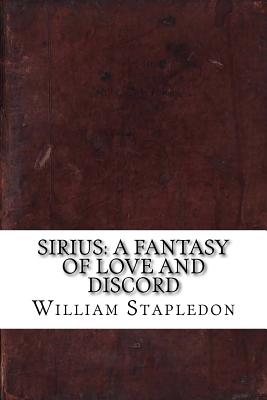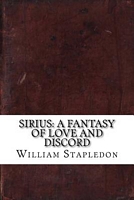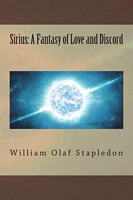- Welcome to FictionDB, Guest
- | My Account
- | Help

Sirius: A Fantasy of Love and Discord — Olaf Stapledon
Sirius is Thomas Trelone's great experiment - a huge, handsome dog with the brain and intelligence of a human being. Raised and educated in Trelone's own family alongside Plaxy, his youngest daughter, Sirius is a truly remarkable and gifted creature. His relationship with the Trelones, particularly with Plaxy, is deep and close, and his inquiring mind ranges across the spectrum of human knowledge and experience. But Sirius isn't human and the conflicts and inner turmoil that torture him cannot be resolved. He was born in Seacombe, Wallasey, on the Wirral peninsula near Liverpool, the only son of William Clibbert Stapledon and Emmeline Miller. The first six years of his life were spent with his parents at Port Said. He was educated at Abbotsholme School and Balliol College, Oxford, where he acquired a BA in Modern History in 1909 and a Master's degree in 1913 citation needed]. After a brief stint as a teacher at Manchester Grammar School, he worked in shipping offices in Liverpool and Port Said from 1910 to 1913. During World War I he served with the Friends' Ambulance Unit in France and Belgium from July 1915 to January 1919. On 16 July 1919 he married Agnes Zena Miller (1894-1984), an Australian cousin whom he had first met in 1903, and who maintained a correspondence with him throughout the war from her home in Sydney. They had a daughter, Mary Sydney Stapledon (1920-), and a son, John David Stapledon (1923-). In 1920 they moved to West Kirby, and in 1925 Stapledon was awarded a PhD in philosophy from the University of Liverpool. He wrote A Modern Theory of Ethics, which was published in 1929. However he soon turned to fiction to present his ideas to a wider public. Last and First Men was very successful and prompted him to become a full-time writer. He wrote a sequel, and followed it up with many more books on subjects associated with what is now called Transhumanism. In 1940 the family built and moved into Simon's Field, in Caldy. After 1945 Stapledon travelled widely on lecture tours, visiting the Netherlands, Sweden and France, and in 1948 he spoke at the Congress of Intellectuals for Peace in Wrocl/aw, Poland. He attended the Conference for World Peace held in New York in 1949, the only Briton to be granted a visa to do so. In 1950 he became involved with the anti-apartheid movement; after a week of lectures in Paris, he cancelled a projected trip to Yugoslavia and returned to his home in Caldy, where he died very suddenly of a heart attack. Olaf Stapledon was cremated at Landican Crematorium; his widow Agnes and their children Mary and John scattered his ashes on the sandy cliffs overlooking the Dee Estuary, a favourite spot of Olaf's, and a location that features in more than one of his books.
Sub-Genres
Click on any of the links above to see more books like this one.



